HI6028 Taxation Law: Case Law Application to RIP Pty Ltd Analysis
VerifiedAdded on 2024/05/14
|11
|2913
|277
Case Study
AI Summary
This case study analyzes the taxation implications for RIP Pty Ltd, focusing on the application of the Arthur Murray (NSW) Pty Ltd v FCT case regarding prepayments. It discusses whether advance payments for funeral services should be included in assessable income immediately or when the service is provided. The analysis also covers the treatment of forfeited amounts, stock valuation, dividend income, and prepaid expenses, providing advice on compliance with relevant tax laws. The study uses relevant case laws and provisions of the act to guide the company in making appropriate financial decisions and tax treatments.
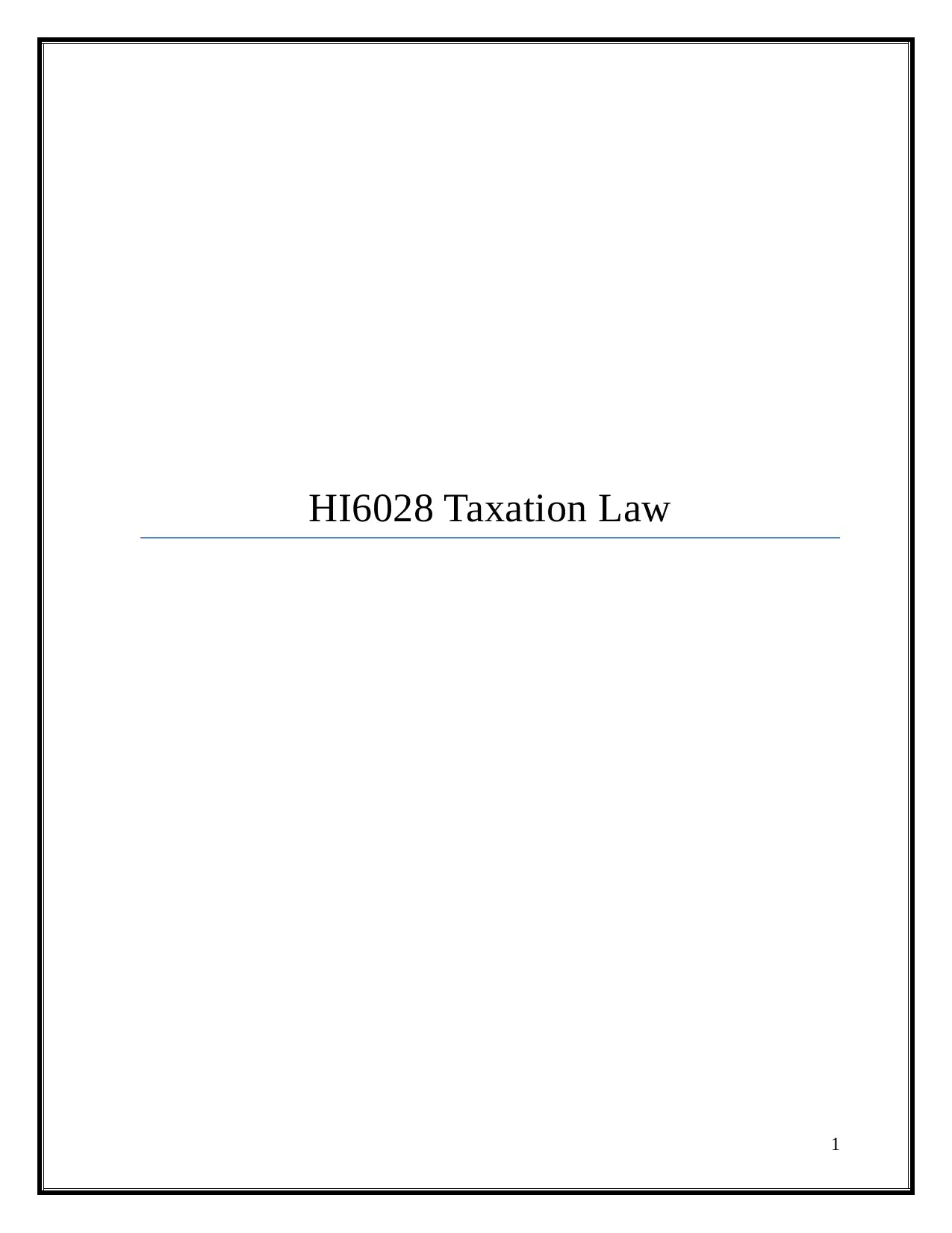
HI6028 Taxation Law
1
1
Paraphrase This Document
Need a fresh take? Get an instant paraphrase of this document with our AI Paraphraser

Table of Contents
Introduction......................................................................................................................................3
PART A...........................................................................................................................................4
PART B...........................................................................................................................................7
Conclusion.....................................................................................................................................10
References......................................................................................................................................11
2
Introduction......................................................................................................................................3
PART A...........................................................................................................................................4
PART B...........................................................................................................................................7
Conclusion.....................................................................................................................................10
References......................................................................................................................................11
2

Introduction
In the global economy, there are various tax laws which are to be complied with and all the
companies on which they are applicable are required to follow them. For that, there will be the
need to gain the understanding of the same. By the help of them, it will be possible for them to
carry the business in the best possible manner as all of the issues in this relation will be resolved
in the proper manner. In this report, the case laws will be used and on that basis, the decisions
will be made and also the provisions of the act will be taken into consideration.
3
In the global economy, there are various tax laws which are to be complied with and all the
companies on which they are applicable are required to follow them. For that, there will be the
need to gain the understanding of the same. By the help of them, it will be possible for them to
carry the business in the best possible manner as all of the issues in this relation will be resolved
in the proper manner. In this report, the case laws will be used and on that basis, the decisions
will be made and also the provisions of the act will be taken into consideration.
3
⊘ This is a preview!⊘
Do you want full access?
Subscribe today to unlock all pages.

Trusted by 1+ million students worldwide

PART A
a) Description of Arthur Murray (NSW) Pty Ltd v FCT (1965) case.
In the company, there will be various decisions which will be required to be made and for that, it
is needed that the understanding shall be obtained. One such item is related to the prepayments
and for that, the company will be using the judgment of the case Arthur Murray (NSW) Pty Ltd v
FCT (1965) 114 CLR 314. By this, it will be determined that the amount that is for the same will
be included in the assessable income or not.
Facts of the case:
The case which has been selected is for the treatment of the prepayments which are included in
the business. According to this, the entity is providing the services of the dance and in relation to
them, the students will be taking the payment at the time of taking the service on the per hour
basis. Then to make it simple company introduced a scheme in which all of the clients will have
to make the advance payment for the 1200 hours and then can avail service whenever they are
willing to in the lifetime. There is the discount also which can be taken if they make the payment
immediately (ATO, 2018). The company will not be liable to make the refund of any amount if
there is ant service which is not availed and the amount related to the same will be forfeited and
transferred to another account.
Issue related to the case:
The company is facing an issue in this respect as the company is of the view that the amount of
prepayment will be required to be included in the accounts when the service will be provided and
not at the current period. They are not including it in the calculation of the assessable income of
the company. In contrary to this the commissioner is of the thought that the amount of this will
be taken into account in the current period only and there is no relevance of the service
provision. They feel that the receipt of the amount is the final aspect and it will be used for the
determination of the total assessable income. So the decision is to be taken in this relation
The conclusion is drawn from the case:
4
a) Description of Arthur Murray (NSW) Pty Ltd v FCT (1965) case.
In the company, there will be various decisions which will be required to be made and for that, it
is needed that the understanding shall be obtained. One such item is related to the prepayments
and for that, the company will be using the judgment of the case Arthur Murray (NSW) Pty Ltd v
FCT (1965) 114 CLR 314. By this, it will be determined that the amount that is for the same will
be included in the assessable income or not.
Facts of the case:
The case which has been selected is for the treatment of the prepayments which are included in
the business. According to this, the entity is providing the services of the dance and in relation to
them, the students will be taking the payment at the time of taking the service on the per hour
basis. Then to make it simple company introduced a scheme in which all of the clients will have
to make the advance payment for the 1200 hours and then can avail service whenever they are
willing to in the lifetime. There is the discount also which can be taken if they make the payment
immediately (ATO, 2018). The company will not be liable to make the refund of any amount if
there is ant service which is not availed and the amount related to the same will be forfeited and
transferred to another account.
Issue related to the case:
The company is facing an issue in this respect as the company is of the view that the amount of
prepayment will be required to be included in the accounts when the service will be provided and
not at the current period. They are not including it in the calculation of the assessable income of
the company. In contrary to this the commissioner is of the thought that the amount of this will
be taken into account in the current period only and there is no relevance of the service
provision. They feel that the receipt of the amount is the final aspect and it will be used for the
determination of the total assessable income. So the decision is to be taken in this relation
The conclusion is drawn from the case:
4
Paraphrase This Document
Need a fresh take? Get an instant paraphrase of this document with our AI Paraphraser

The company has identified that in the case which is provided the act is specifying the definition
of the income and according to that, it will be considered as the one when the company will be
providing the service and only the receipt of the amount will not make it the income. There will
be only the contract in accordance with which the amount has been received, Due to this the
treatment which has been providing by the entity will be considered as correct and it is
complying with all of the laws. There will be the inclusion of the same in the income when the
service will be provided by the company to its clients.
In the given company which is RIP Pty Ltd, it is involved in the service of the funeral which is
provided by it. The company will be required to provide the services and then the amount will be
received. In this, the client will be making the payment and then if the service is not given then
the forfeited account will be used and that amount will be transferred to the same. The company
is given the following advice in relation to the issues which are arising in the company.
The company is providing the services and they will be receiving the payment from the
company after the services are provided. It is following the policy of 30 days invoice.
The company will be receiving the advance then it will not be required to include the
same in the assessable income as that will not be considered as the earned until the
provision of the service has been made to the party involved in this. The company will be
including the amount of the income if it will be received after the services are provided.
So the conclusion can be drawn from the same that both the conditions are necessary and
will have to be fulfilled before inclusion of the amount in the income and they are the
service providing and receipt of amount.
The company is also providing the deluxe facilities in the easy funeral plan and in that all
of the clients will be required to make the payment for the services to be provided in
advance. They will be availing the services in the future and this amount will be
considered as the prepayments and so the company will be able to apply the case which
has been discussed above (Austlii, 2018). There will be no refund which the company
will be making and the forfeiture will be made for the amount in relation to which the
services are not provided. By the help of this, the assessable income will be calculated
inappropriate manner. The company will be including the amount of the income only
after the service will be provided by the company to the one who made the payment in
5
of the income and according to that, it will be considered as the one when the company will be
providing the service and only the receipt of the amount will not make it the income. There will
be only the contract in accordance with which the amount has been received, Due to this the
treatment which has been providing by the entity will be considered as correct and it is
complying with all of the laws. There will be the inclusion of the same in the income when the
service will be provided by the company to its clients.
In the given company which is RIP Pty Ltd, it is involved in the service of the funeral which is
provided by it. The company will be required to provide the services and then the amount will be
received. In this, the client will be making the payment and then if the service is not given then
the forfeited account will be used and that amount will be transferred to the same. The company
is given the following advice in relation to the issues which are arising in the company.
The company is providing the services and they will be receiving the payment from the
company after the services are provided. It is following the policy of 30 days invoice.
The company will be receiving the advance then it will not be required to include the
same in the assessable income as that will not be considered as the earned until the
provision of the service has been made to the party involved in this. The company will be
including the amount of the income if it will be received after the services are provided.
So the conclusion can be drawn from the same that both the conditions are necessary and
will have to be fulfilled before inclusion of the amount in the income and they are the
service providing and receipt of amount.
The company is also providing the deluxe facilities in the easy funeral plan and in that all
of the clients will be required to make the payment for the services to be provided in
advance. They will be availing the services in the future and this amount will be
considered as the prepayments and so the company will be able to apply the case which
has been discussed above (Austlii, 2018). There will be no refund which the company
will be making and the forfeiture will be made for the amount in relation to which the
services are not provided. By the help of this, the assessable income will be calculated
inappropriate manner. The company will be including the amount of the income only
after the service will be provided by the company to the one who made the payment in
5
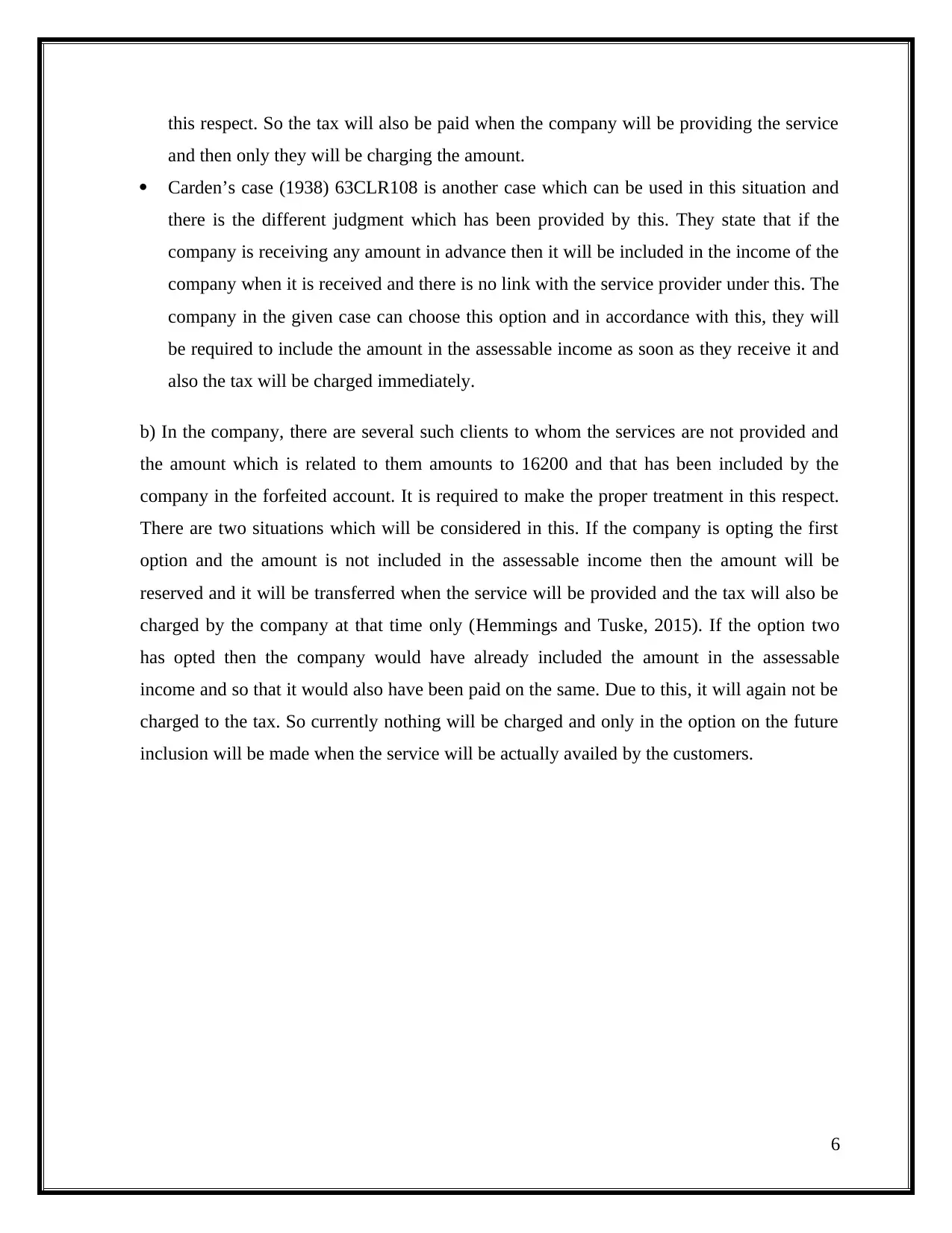
this respect. So the tax will also be paid when the company will be providing the service
and then only they will be charging the amount.
Carden’s case (1938) 63CLR108 is another case which can be used in this situation and
there is the different judgment which has been provided by this. They state that if the
company is receiving any amount in advance then it will be included in the income of the
company when it is received and there is no link with the service provider under this. The
company in the given case can choose this option and in accordance with this, they will
be required to include the amount in the assessable income as soon as they receive it and
also the tax will be charged immediately.
b) In the company, there are several such clients to whom the services are not provided and
the amount which is related to them amounts to 16200 and that has been included by the
company in the forfeited account. It is required to make the proper treatment in this respect.
There are two situations which will be considered in this. If the company is opting the first
option and the amount is not included in the assessable income then the amount will be
reserved and it will be transferred when the service will be provided and the tax will also be
charged by the company at that time only (Hemmings and Tuske, 2015). If the option two
has opted then the company would have already included the amount in the assessable
income and so that it would also have been paid on the same. Due to this, it will again not be
charged to the tax. So currently nothing will be charged and only in the option on the future
inclusion will be made when the service will be actually availed by the customers.
6
and then only they will be charging the amount.
Carden’s case (1938) 63CLR108 is another case which can be used in this situation and
there is the different judgment which has been provided by this. They state that if the
company is receiving any amount in advance then it will be included in the income of the
company when it is received and there is no link with the service provider under this. The
company in the given case can choose this option and in accordance with this, they will
be required to include the amount in the assessable income as soon as they receive it and
also the tax will be charged immediately.
b) In the company, there are several such clients to whom the services are not provided and
the amount which is related to them amounts to 16200 and that has been included by the
company in the forfeited account. It is required to make the proper treatment in this respect.
There are two situations which will be considered in this. If the company is opting the first
option and the amount is not included in the assessable income then the amount will be
reserved and it will be transferred when the service will be provided and the tax will also be
charged by the company at that time only (Hemmings and Tuske, 2015). If the option two
has opted then the company would have already included the amount in the assessable
income and so that it would also have been paid on the same. Due to this, it will again not be
charged to the tax. So currently nothing will be charged and only in the option on the future
inclusion will be made when the service will be actually availed by the customers.
6
⊘ This is a preview!⊘
Do you want full access?
Subscribe today to unlock all pages.

Trusted by 1+ million students worldwide
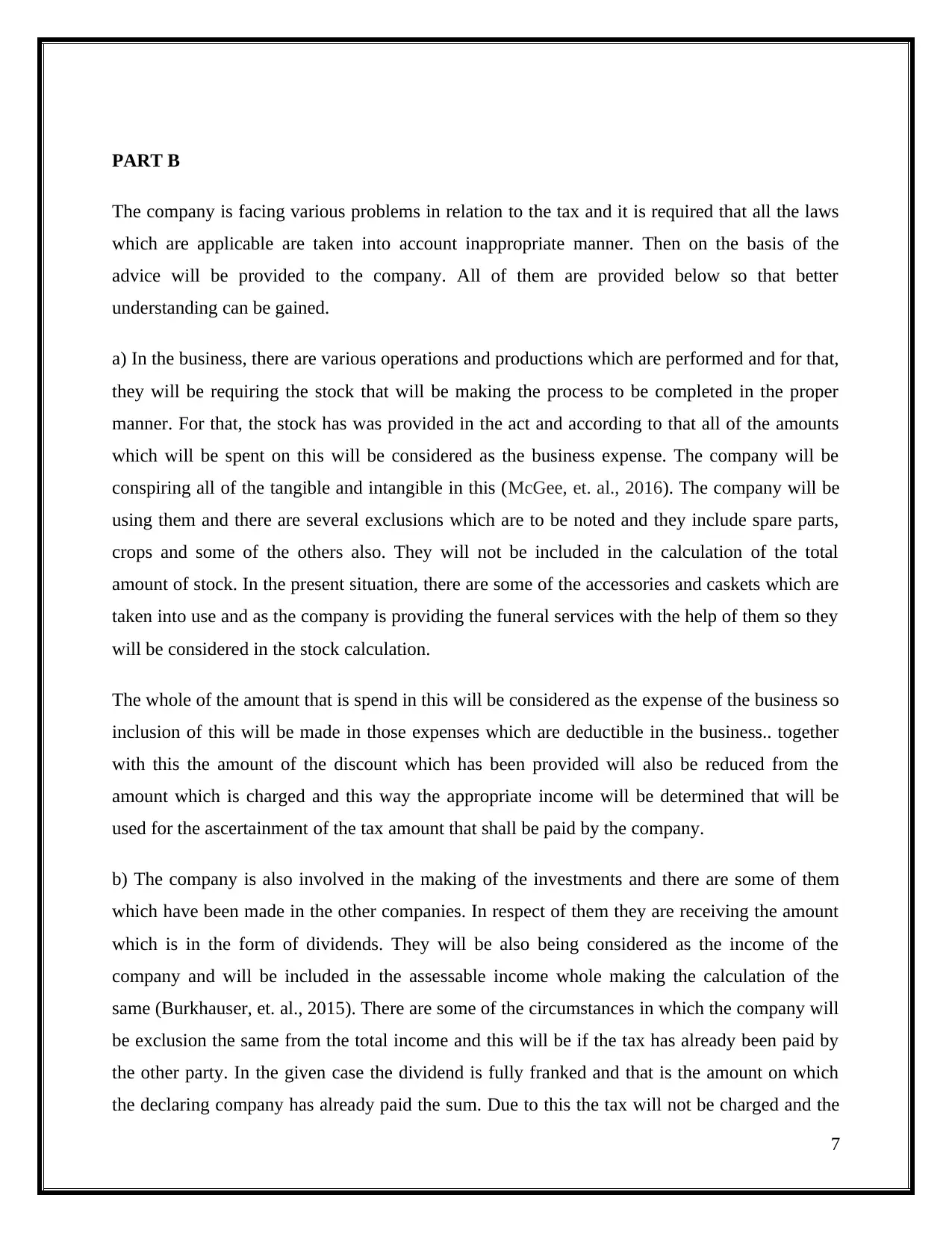
PART B
The company is facing various problems in relation to the tax and it is required that all the laws
which are applicable are taken into account inappropriate manner. Then on the basis of the
advice will be provided to the company. All of them are provided below so that better
understanding can be gained.
a) In the business, there are various operations and productions which are performed and for that,
they will be requiring the stock that will be making the process to be completed in the proper
manner. For that, the stock has was provided in the act and according to that all of the amounts
which will be spent on this will be considered as the business expense. The company will be
conspiring all of the tangible and intangible in this (McGee, et. al., 2016). The company will be
using them and there are several exclusions which are to be noted and they include spare parts,
crops and some of the others also. They will not be included in the calculation of the total
amount of stock. In the present situation, there are some of the accessories and caskets which are
taken into use and as the company is providing the funeral services with the help of them so they
will be considered in the stock calculation.
The whole of the amount that is spend in this will be considered as the expense of the business so
inclusion of this will be made in those expenses which are deductible in the business.. together
with this the amount of the discount which has been provided will also be reduced from the
amount which is charged and this way the appropriate income will be determined that will be
used for the ascertainment of the tax amount that shall be paid by the company.
b) The company is also involved in the making of the investments and there are some of them
which have been made in the other companies. In respect of them they are receiving the amount
which is in the form of dividends. They will be also being considered as the income of the
company and will be included in the assessable income whole making the calculation of the
same (Burkhauser, et. al., 2015). There are some of the circumstances in which the company will
be exclusion the same from the total income and this will be if the tax has already been paid by
the other party. In the given case the dividend is fully franked and that is the amount on which
the declaring company has already paid the sum. Due to this the tax will not be charged and the
7
The company is facing various problems in relation to the tax and it is required that all the laws
which are applicable are taken into account inappropriate manner. Then on the basis of the
advice will be provided to the company. All of them are provided below so that better
understanding can be gained.
a) In the business, there are various operations and productions which are performed and for that,
they will be requiring the stock that will be making the process to be completed in the proper
manner. For that, the stock has was provided in the act and according to that all of the amounts
which will be spent on this will be considered as the business expense. The company will be
conspiring all of the tangible and intangible in this (McGee, et. al., 2016). The company will be
using them and there are several exclusions which are to be noted and they include spare parts,
crops and some of the others also. They will not be included in the calculation of the total
amount of stock. In the present situation, there are some of the accessories and caskets which are
taken into use and as the company is providing the funeral services with the help of them so they
will be considered in the stock calculation.
The whole of the amount that is spend in this will be considered as the expense of the business so
inclusion of this will be made in those expenses which are deductible in the business.. together
with this the amount of the discount which has been provided will also be reduced from the
amount which is charged and this way the appropriate income will be determined that will be
used for the ascertainment of the tax amount that shall be paid by the company.
b) The company is also involved in the making of the investments and there are some of them
which have been made in the other companies. In respect of them they are receiving the amount
which is in the form of dividends. They will be also being considered as the income of the
company and will be included in the assessable income whole making the calculation of the
same (Burkhauser, et. al., 2015). There are some of the circumstances in which the company will
be exclusion the same from the total income and this will be if the tax has already been paid by
the other party. In the given case the dividend is fully franked and that is the amount on which
the declaring company has already paid the sum. Due to this the tax will not be charged and the
7
Paraphrase This Document
Need a fresh take? Get an instant paraphrase of this document with our AI Paraphraser
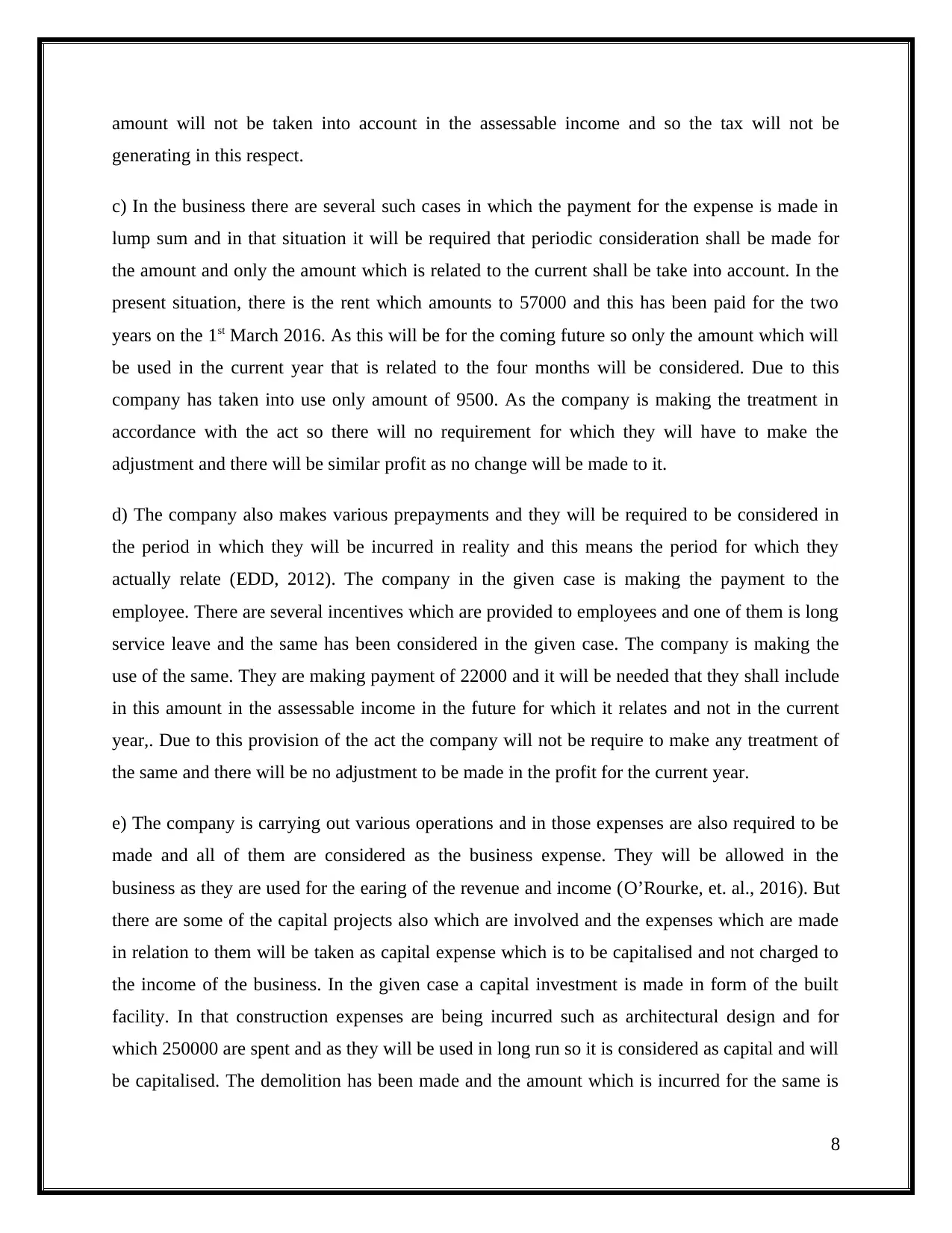
amount will not be taken into account in the assessable income and so the tax will not be
generating in this respect.
c) In the business there are several such cases in which the payment for the expense is made in
lump sum and in that situation it will be required that periodic consideration shall be made for
the amount and only the amount which is related to the current shall be take into account. In the
present situation, there is the rent which amounts to 57000 and this has been paid for the two
years on the 1st March 2016. As this will be for the coming future so only the amount which will
be used in the current year that is related to the four months will be considered. Due to this
company has taken into use only amount of 9500. As the company is making the treatment in
accordance with the act so there will no requirement for which they will have to make the
adjustment and there will be similar profit as no change will be made to it.
d) The company also makes various prepayments and they will be required to be considered in
the period in which they will be incurred in reality and this means the period for which they
actually relate (EDD, 2012). The company in the given case is making the payment to the
employee. There are several incentives which are provided to employees and one of them is long
service leave and the same has been considered in the given case. The company is making the
use of the same. They are making payment of 22000 and it will be needed that they shall include
in this amount in the assessable income in the future for which it relates and not in the current
year,. Due to this provision of the act the company will not be require to make any treatment of
the same and there will be no adjustment to be made in the profit for the current year.
e) The company is carrying out various operations and in those expenses are also required to be
made and all of them are considered as the business expense. They will be allowed in the
business as they are used for the earing of the revenue and income (O’Rourke, et. al., 2016). But
there are some of the capital projects also which are involved and the expenses which are made
in relation to them will be taken as capital expense which is to be capitalised and not charged to
the income of the business. In the given case a capital investment is made in form of the built
facility. In that construction expenses are being incurred such as architectural design and for
which 250000 are spent and as they will be used in long run so it is considered as capital and will
be capitalised. The demolition has been made and the amount which is incurred for the same is
8
generating in this respect.
c) In the business there are several such cases in which the payment for the expense is made in
lump sum and in that situation it will be required that periodic consideration shall be made for
the amount and only the amount which is related to the current shall be take into account. In the
present situation, there is the rent which amounts to 57000 and this has been paid for the two
years on the 1st March 2016. As this will be for the coming future so only the amount which will
be used in the current year that is related to the four months will be considered. Due to this
company has taken into use only amount of 9500. As the company is making the treatment in
accordance with the act so there will no requirement for which they will have to make the
adjustment and there will be similar profit as no change will be made to it.
d) The company also makes various prepayments and they will be required to be considered in
the period in which they will be incurred in reality and this means the period for which they
actually relate (EDD, 2012). The company in the given case is making the payment to the
employee. There are several incentives which are provided to employees and one of them is long
service leave and the same has been considered in the given case. The company is making the
use of the same. They are making payment of 22000 and it will be needed that they shall include
in this amount in the assessable income in the future for which it relates and not in the current
year,. Due to this provision of the act the company will not be require to make any treatment of
the same and there will be no adjustment to be made in the profit for the current year.
e) The company is carrying out various operations and in those expenses are also required to be
made and all of them are considered as the business expense. They will be allowed in the
business as they are used for the earing of the revenue and income (O’Rourke, et. al., 2016). But
there are some of the capital projects also which are involved and the expenses which are made
in relation to them will be taken as capital expense which is to be capitalised and not charged to
the income of the business. In the given case a capital investment is made in form of the built
facility. In that construction expenses are being incurred such as architectural design and for
which 250000 are spent and as they will be used in long run so it is considered as capital and will
be capitalised. The demolition has been made and the amount which is incurred for the same is
8
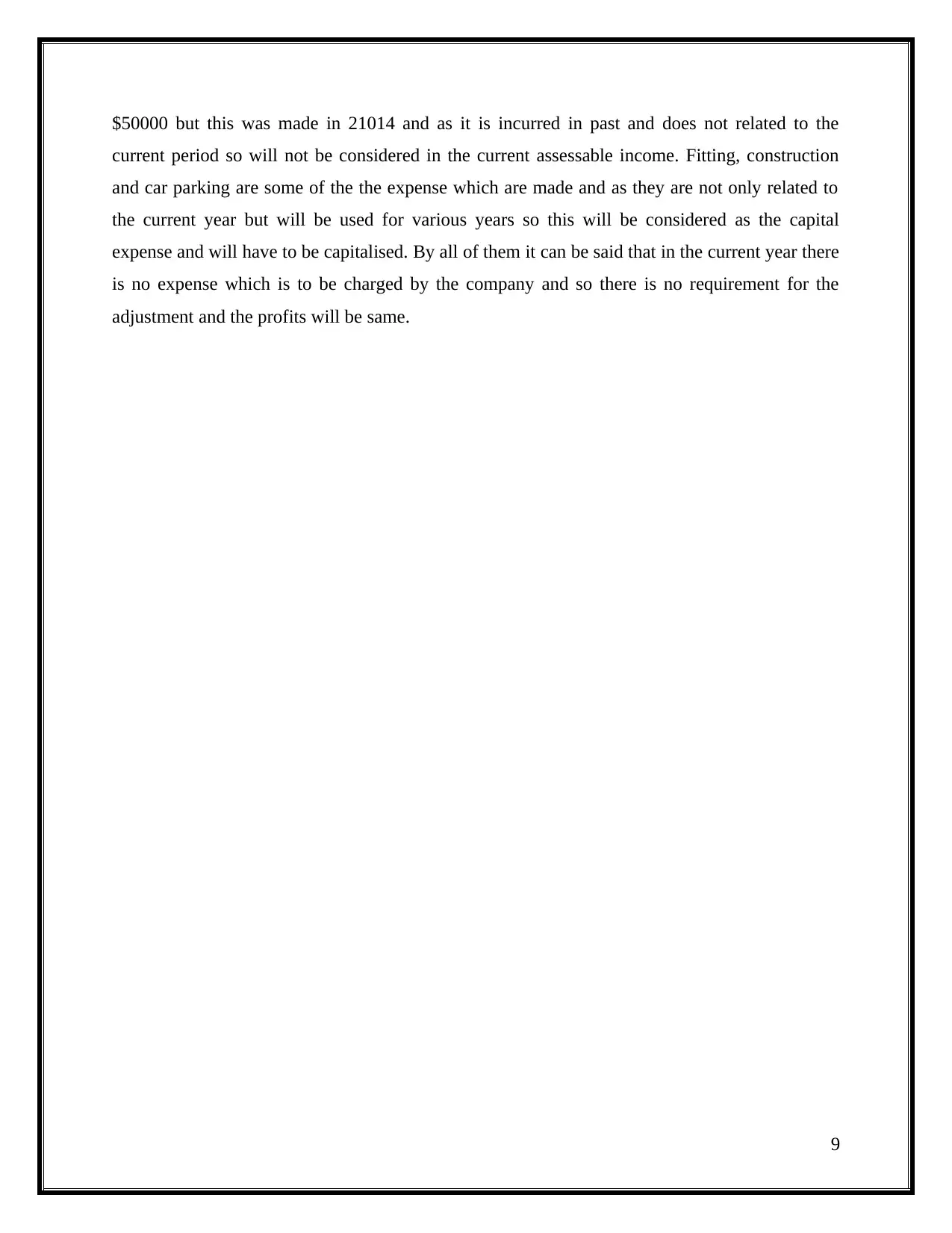
$50000 but this was made in 21014 and as it is incurred in past and does not related to the
current period so will not be considered in the current assessable income. Fitting, construction
and car parking are some of the the expense which are made and as they are not only related to
the current year but will be used for various years so this will be considered as the capital
expense and will have to be capitalised. By all of them it can be said that in the current year there
is no expense which is to be charged by the company and so there is no requirement for the
adjustment and the profits will be same.
9
current period so will not be considered in the current assessable income. Fitting, construction
and car parking are some of the the expense which are made and as they are not only related to
the current year but will be used for various years so this will be considered as the capital
expense and will have to be capitalised. By all of them it can be said that in the current year there
is no expense which is to be charged by the company and so there is no requirement for the
adjustment and the profits will be same.
9
⊘ This is a preview!⊘
Do you want full access?
Subscribe today to unlock all pages.

Trusted by 1+ million students worldwide
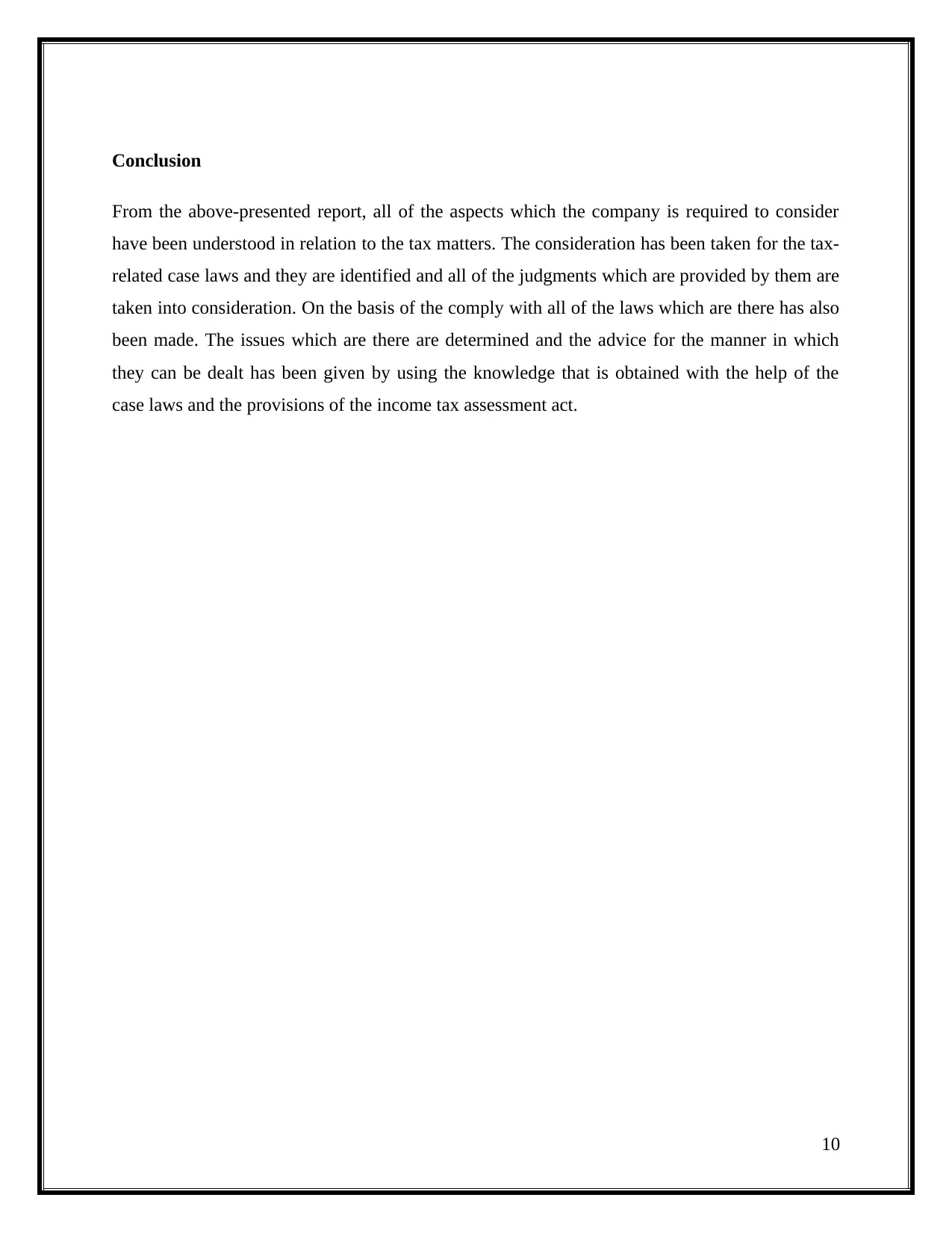
Conclusion
From the above-presented report, all of the aspects which the company is required to consider
have been understood in relation to the tax matters. The consideration has been taken for the tax-
related case laws and they are identified and all of the judgments which are provided by them are
taken into consideration. On the basis of the comply with all of the laws which are there has also
been made. The issues which are there are determined and the advice for the manner in which
they can be dealt has been given by using the knowledge that is obtained with the help of the
case laws and the provisions of the income tax assessment act.
10
From the above-presented report, all of the aspects which the company is required to consider
have been understood in relation to the tax matters. The consideration has been taken for the tax-
related case laws and they are identified and all of the judgments which are provided by them are
taken into consideration. On the basis of the comply with all of the laws which are there has also
been made. The issues which are there are determined and the advice for the manner in which
they can be dealt has been given by using the knowledge that is obtained with the help of the
case laws and the provisions of the income tax assessment act.
10
Paraphrase This Document
Need a fresh take? Get an instant paraphrase of this document with our AI Paraphraser
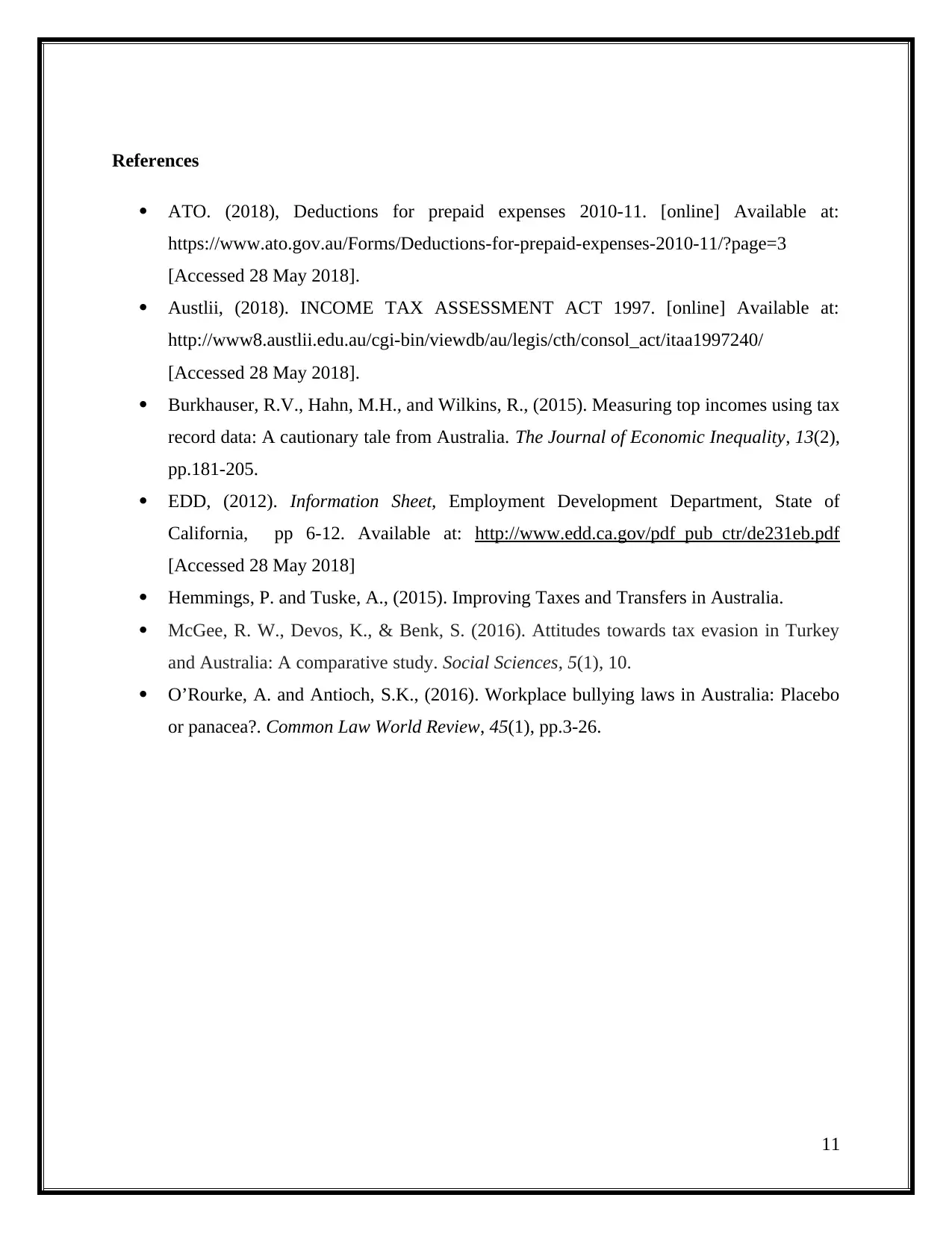
References
ATO. (2018), Deductions for prepaid expenses 2010-11. [online] Available at:
https://www.ato.gov.au/Forms/Deductions-for-prepaid-expenses-2010-11/?page=3
[Accessed 28 May 2018].
Austlii, (2018). INCOME TAX ASSESSMENT ACT 1997. [online] Available at:
http://www8.austlii.edu.au/cgi-bin/viewdb/au/legis/cth/consol_act/itaa1997240/
[Accessed 28 May 2018].
Burkhauser, R.V., Hahn, M.H., and Wilkins, R., (2015). Measuring top incomes using tax
record data: A cautionary tale from Australia. The Journal of Economic Inequality, 13(2),
pp.181-205.
EDD, (2012). Information Sheet, Employment Development Department, State of
California, pp 6-12. Available at: http://www.edd.ca.gov/pdf_pub_ctr/de231eb.pdf
[Accessed 28 May 2018]
Hemmings, P. and Tuske, A., (2015). Improving Taxes and Transfers in Australia.
McGee, R. W., Devos, K., & Benk, S. (2016). Attitudes towards tax evasion in Turkey
and Australia: A comparative study. Social Sciences, 5(1), 10.
O’Rourke, A. and Antioch, S.K., (2016). Workplace bullying laws in Australia: Placebo
or panacea?. Common Law World Review, 45(1), pp.3-26.
11
ATO. (2018), Deductions for prepaid expenses 2010-11. [online] Available at:
https://www.ato.gov.au/Forms/Deductions-for-prepaid-expenses-2010-11/?page=3
[Accessed 28 May 2018].
Austlii, (2018). INCOME TAX ASSESSMENT ACT 1997. [online] Available at:
http://www8.austlii.edu.au/cgi-bin/viewdb/au/legis/cth/consol_act/itaa1997240/
[Accessed 28 May 2018].
Burkhauser, R.V., Hahn, M.H., and Wilkins, R., (2015). Measuring top incomes using tax
record data: A cautionary tale from Australia. The Journal of Economic Inequality, 13(2),
pp.181-205.
EDD, (2012). Information Sheet, Employment Development Department, State of
California, pp 6-12. Available at: http://www.edd.ca.gov/pdf_pub_ctr/de231eb.pdf
[Accessed 28 May 2018]
Hemmings, P. and Tuske, A., (2015). Improving Taxes and Transfers in Australia.
McGee, R. W., Devos, K., & Benk, S. (2016). Attitudes towards tax evasion in Turkey
and Australia: A comparative study. Social Sciences, 5(1), 10.
O’Rourke, A. and Antioch, S.K., (2016). Workplace bullying laws in Australia: Placebo
or panacea?. Common Law World Review, 45(1), pp.3-26.
11
1 out of 11
Related Documents
Your All-in-One AI-Powered Toolkit for Academic Success.
+13062052269
info@desklib.com
Available 24*7 on WhatsApp / Email
![[object Object]](/_next/static/media/star-bottom.7253800d.svg)
Unlock your academic potential
Copyright © 2020–2025 A2Z Services. All Rights Reserved. Developed and managed by ZUCOL.





